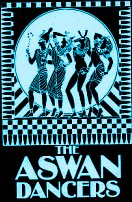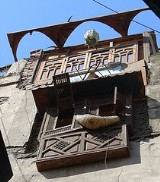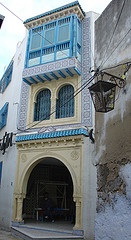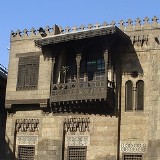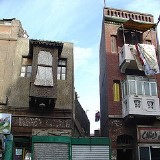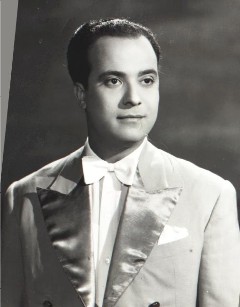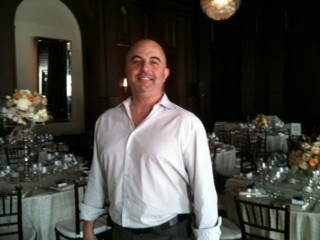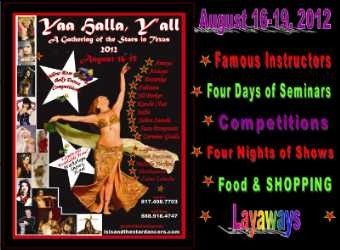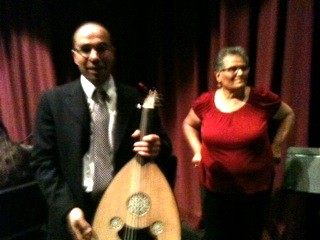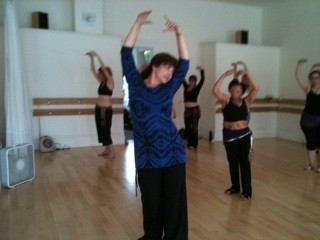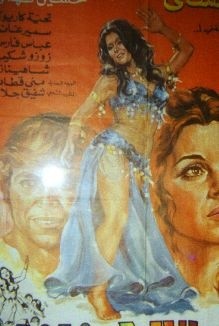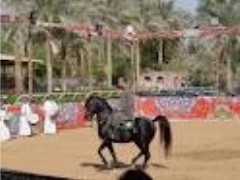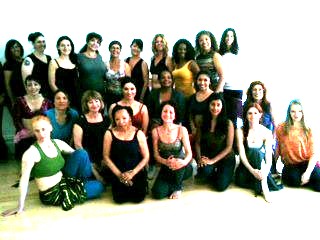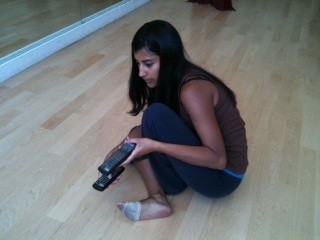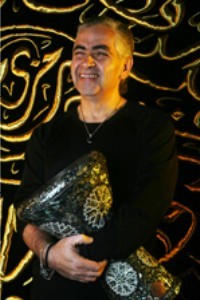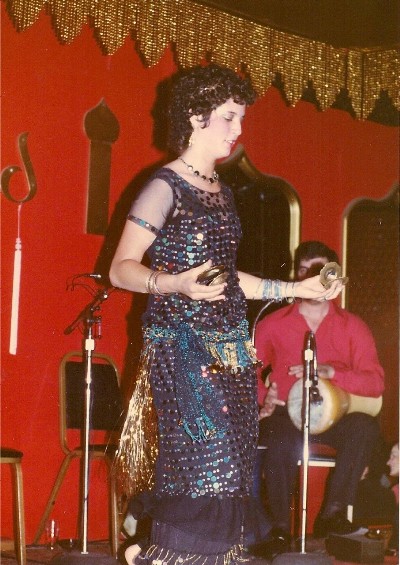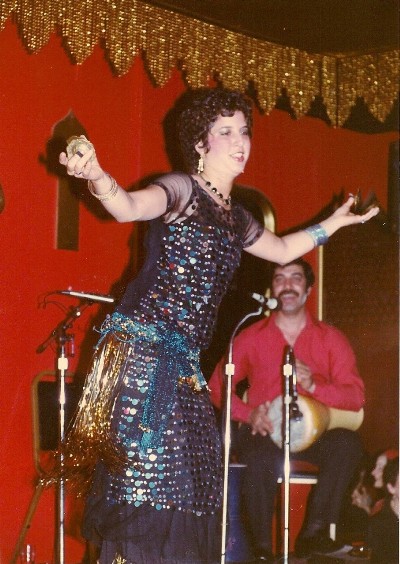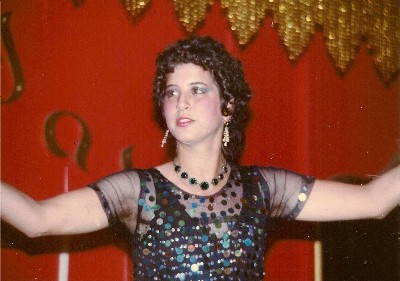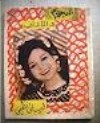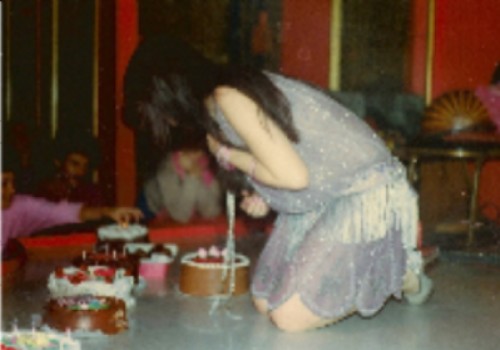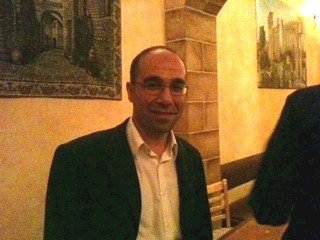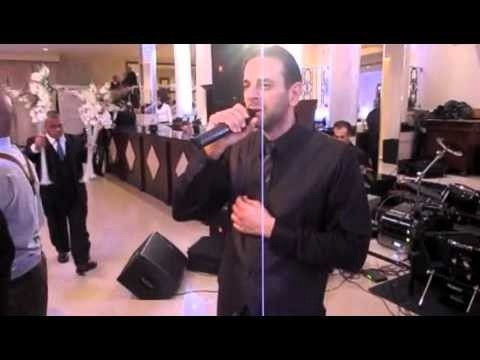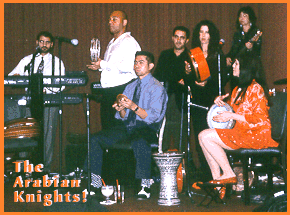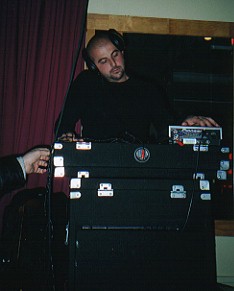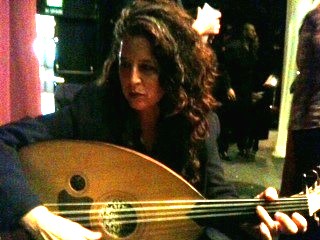Ba Olek Eh - Amina's Daily Blog
(tell you what)
June 20 2012
Wednesday
The balcony
In Egypt a lot of socializing has been done on the balconies.
I guess in San Francisco, the air conditioned city, this isn't necessary
or even practical. But in a relatively hot and dry city like Cairo, it
makes total sense to migrate to the part of the house that provides fresh
cooled air. The balcony also affords the pleasure of people watching and
socializing. In San Francisco, one usually needs to don a sweater or jacket
to be on a balcony; therefore here, balconies are rare or little used.
Balconies in Cairo are plentiful and welcomed open spaces. In the old
days, the balconies were screened off with wooden mashrabiyas.
These beautiful wooden screens didn't just "protect" the women
from the outside world, they also let the women enjoy the outside world.
The word "mashrabiya" comes from the Arabic root word meaning
the "place of drinking (cool water)". Here behind the mashrabiya,
which jutted out from the sheer wall of the house, like a balcony, women
could enjoy fresh air that was almost refrigerated from the sweating of
water evaporating in sun-baked clay pots sitting by the mashrabiya. The
women could dream of social interactions with the people walking on the
street below and so expand their social life - be it in reality or in
their minds.
A couple of songs come to mind when I think of balconies - one is the
song I mentioned yeterday, "Ya Helw Sabah" and the other
is "Taht
il Shibak". There are others too and I like finding references
to these balconies in songs as they provide many fine visuals for my imagination
while dancing. This always makes the dance have more depth and meaning.
"Ya Helwa Sabah" is about a guy who sees a girl and wants her
to notice him while "Taht
il Shibak" is about a girl who sees a guy and wants him to notice
her. When I get around to it - soon, I hope, I will put up translations
of both on my song page. Home
June 19, 2012
Tuesday
Ya Helwa Sabah
Today Ayman helped me with the translation of "Ya
Helwa Sabah". This song, originally sung by Abdel Aziz Mahmoud
(1914-1991), was covered and redone by Shaabi singer Mahmoud
el Leithy a few years ago.
Abdel Aziz Mahmoud was "the captain of romantic pop songs".
He was known for performing in weddings and religious festivals and he
appeared in many musical films in the 1960s. Here's
one scene from the film "Mandil el Helou" (Handkerchief
of the beautiful one) with him singing to Taheya Carioca. He was
popular at the same time as Karem Mahmoud of "Samra ya
Samra" fame.
Abdel Aziz Mahmoud
Karem Mahmoud (1922-1995), (no relation to Abdel Aziz Mahmoud) was known
as "the Melodious Knight", and was also a popular Egyptian
singer and actor during the same time period. In 1953 Karem Mahmoud at
the last minute, couldn't fulfill a live radio show commitment. His substitute
was a young club singer named Abdel Halim. Mohamed Abdel Wahab
heard the show and immediately "discovered" and took Abdel Halim
under his wing. Abdel Halim then took on a new stage name - Abdel Halim
Hafez. He added Hafez (which was Mohamed Abdel Wehab's first name),
as a tribute to his new benefactor and mentor. Because of that radio show,
Abdel Halim won recognition and fame and the rest is history. Karem Mahmoud
continued on to sing and star in movies. Just before Karem Mahoud died,
he told his surgeon to "Please guard my vocal cords throughout the
surgery".
Karem Mahmoud
Here's Karem Mahmoud singing for Naima Akef in the 1954 film
"Nour el Ayoun".
Re the song "El Helwa Sabah" it's kind of like the male response
to "Taht el Shibak". In this song he is asking his neighbor
to look at him. In another blog I'll compare the two songs. Home
June 18, 2012
Monday
Once more with feeling
When I worked at the Bagdad we usually did a straight
Arabic set, but at times some of the musicians and dancers were Turkish
so we would sometimes get a karsilama ending. It was fun watching the
Turkish dancers
and the occasional guest dancer from the East coast do a firey Karsilama
finale.
This was definitely a passionate ending. Sometimes only fast and lively,
but if the dancer and musician grooved, it could also include a very heated
and sensuous taqsim I didn't understand the karsilama
rhythm very well and found it hard to dance to.
And some of the dancing, especially the taqsim, bordered on being slightly "off-color" with lots of provocative stomach drops, flutters, suggestive pelvic bumps and accompanying hand gestures. I enjoyed the hops and skips and the skirt dancing with the dropping pelvis - almost reminded me of Moroccan Schihatt dancing. Since my teacher, Bettina, learned to dance in Morocco I had already learned quite a bit of stomach dropping and pelvic tilting so that part of the dance was easy for me. I found the hand gestures a bit embarrassing to do, so I usually just held my skirts and tossed them as I hopped and skipped through the dance.
Tonight in drum class, I decided that I would teach the 9/8 karsilama
rhythm in drum class. One of the students had expressed an interest in
taking Zadiel's Turkish classes
and I wanted to prepare her to be able to internalize the rhythm. The
best way to do that is to be able to drum it out. It then becomes part
of your body. Susu says if you can say it (the rhythm), you can play it.
I take it one step further and if you can play it, you can dance it. And
you can dance it with feeling.Home
June 17 2012
Sunday
Aesop's fable - The tortoise and the hare
Today was Gregory's birthday so we did what he
liked. We just hung out and did nothing. It was a pretty relaxing day.
No Arabic nothing today. No dance, no music. Somewhere in the back of
my mind was a show in the East Bay with Jalal, a workshop and show
with Elias the keyboard player put on by Adriana and MaShuqa's
dancers' night at Al Masri. Oh well. It was kind of fun doing nothing.
But now I have nothing to report or blog about.
I sent three dancers to MaShuqa's event - Christie, Anessa and
Rebecca. I wonder how they did. I wished I could have seen them.
I'm sure they did well, but it would have been nice to be there for them.
I guess I'll save that for another time.
MaShuqa told me that one time Carl spent some time - just a little
bit of time - on the internet and discovered an astronomical number of
dance events happening every weekend. He claimed every area in the country
had multiple events. This is amazing. I wonder how many dancers there
are to attend or perform in these events. Fathi el Gerah one time
made some sort of informal survey and told me that it numbered in the
millions. Çould I have heard right? Millions? Not thousands? I
think I probably heard right.
When I think back, way back, way back when I first got involved in this.
There was only one club in San Francisco and no other events. This club
was the Bagdad. Before the Bagdad there was a coffee house called
the Vagabond, then there was 12 Adler Place and then Gigi's.
As each club stopped offering live music with accompanying belly dancers,
the next one would start offering Middle Eastern entertainment. I started
working at the Bagdad just after Gigi's stopped offering dancers. This
was the beginning of 1966. I started working at the Bagdad just a few
short months - six to be exact - after I took my first belly dance lesson.
There was no competition then. There weren't hundreds or thousands of
dancers clamoring to be seen and be hired. There were only a handful of
us. I was fortunate to have been around at that time.
Since I'm not a very competitive person, who knows how I might have fared
if I actually had to audition for a job. I don't want to even think of
it. The main thing that I have going for myself is stick-to-it-ness. I
just won't go away, so I sometimes win by default.
Here I am almost half a century later still plugging away. Now that's
what I call real turtleism.
 Home
Home
June 16 2012
Saturday
Another wedding
A while back Nabila asked the Aswat Women's
Ensemble if we were free to play at College of San Mateo as
part of Egyptian TV star Bassem Youssef's show called "Live
in America". I committed myself to be part of the show.
In the meantime, Nabila got a call for Aswat musicians to play
at a wedding in San Francisco and she asked Susu to play at the
wedding. Well then, which girl drummer would be drumming at the College
of San Mateo show? Certainly not me. I'm not a main drummer. I can be,
if the gig is low-keyed and informal, but for a major show? Uh oh, absolutely
not. No way!
Anyway, it was easy to turn down that position because Nabila didn't ask
me. Apparently she didn't think any of us girls (with the exception of
Susu who was not available) would cut it. I sort of agree. So in the end,
rather than humiliate ourselves and Aswat, Nabila thought better of it
and changed the Aswat program to other players such as Nejad Mohammed,
Fathi al Gerah plus Angela, Hani and a few Aswat singers.
Where did that leave me, since I had reserved June 16 for Aswat? Well,
I got an email from Nabila asking if I'd like to be part of the wedding
band. Yeah, you know the answer to that. How could I refuse? The other
players would be Susu, Husain, Younes, Jalal and Hector.
All of them were my buddies and fellow members of The Pasha Band.
So, rather than be audience at the "Live in America" show in
San Mateo - think drive on the freeway - I got to do a wedding in San
Francisco, my own home town, a few minutes from home. Yay!
When we walked into the ballroom, who did we see but Raffy. Raffy
is Jacques' brother and he used to DJ during breaks when the Arabian
Knights played Salamat
Sundays at El Valenciano, Club Galia and Tropigala.
Every so often we run into him at events where we play and he DJ's.
While playing, I noticed that one of the guests was Father Nicholas
from St. Nicholas Church. This reminded me that I need to put their
food festival on our calendar. This is the annual event that happens the
last weekend of August. I wonder who'll be dancing with us this year.
Yum, am looking forward to the "salty chicken" and the other
goodies such as their koshari, rice and okra, lamb shawerma, kibbeh and,
of course, the knafeh. On Sunday late, all the pastries go half price.
What does that tell you I do?Home
June 15 2012
Friday
The Belly Dance Chronicles
Today I got my copy of "The Belly Dance Chronicles".
This is a dance magazine that comes out quarterly. It is run by Dell
and Isis of Texas and they also sponsor an annual event called
Yaa
Halla, Y'all. I've never been to this event as it's in Texas. Susu
is an on again, off again workshop teacher there and she'll be teaching
there this year, August 16-19. It looks like a good festival and has a
great line up of teachers including our own Shoshanna, MaShuqa, Jill
Parker and Sahra.
This issue of the
Chronicles includes an article I wrote and I hope that you find a
way to read it either by subscribing, buying an individual copy or coming
to my studio and reading my copy. I had fun writing it and finding photos
to go with the article called "The Splendor that was Mohamed Ali
Street".
Hopefully, if all goes well in Egypt, insha'allah, I plan on going to
Cairo next year to see a sequel to my article. I sure hope all goes well
enough to allow that to happen.Home
June 14 2012
Thursday
Dancing at On Lok
Kim and I danced at On Lok, a senior care
facility. I've been doing this regularly for over twenty years. Most recently
my dance partners have been either Bianca or Kim. Today when Kim
was dancing, one of the patients forgot he couldn't walk very well and
actually got up and started dancing with her. Another elderly gentleman
told us he did martial arts and I was again reminded of how this dance
shares so many common elements with martial arts in the placement of,
conserving and recycling energy.
One time a patient in a wheel chair seemed completely out of it and inattentive
but when I approached him, he lit up and started going through the basic
Yang style Tai Chi form. He couldn't stand, he couldn't dance,
but he did dance in the only way he remembered. Jumping out somewhere
in the recesses of his mind was another life full of life. It was a very
uplifting sight to see.
Here are a couple of examples of
tai chi belly dance fusion and
tribal fusion bellydance.
If I could find a few example of this fusion, there must be other crazy
people out there seeing a similarity.
But really what I am talking about is not really fusing the two styles
but incorporating the same energy in order to have a grounded feeling
to the dance while also being graceful and lithe while seemingly expending
no extra energy. It's a matter being in complete control of the body,
being at ease and at the same time being able to call forth great dynamics.Home
June 13, 2012
Wednesday
Souq al banat
I got a call today from Giselle who used to dance
with me about fifteen years ago. She was sixteen when she started dancing
with me. She dropped in on a class a few years ago but then disappeared
until very recently. She wants to start dancing again and I am sure that
she's only gotten better through maturity. It will be nice to see her
again.
She reminded me of the song "Shokolata"
because years ago she had translated it for me. This is a great song and
works really well at parties because it already sounds like a party. Giselle
is Jordanian who loves Egyptian music, dancing and speaks Egyptian dialect.
Maybe if she comes around more often, I won't feel so shy about trying
to speak Egyptian.
In the film "Sharia al Haram", Dina and Saad do
a version of Shokolata. Also in the film, Mahmoud el Leithy and
Ayten Amer do a version of "El Hikaya". However
the big hit in the film is "Souk
al Banat". It's such a big hit that I found a you tube clip with
Soraia Zaied in New York claiming
"For the first
time in USA! - Souk el banat". It is a fun song, but to announce
"For the first time in USA!"?? It's not that big a deal. Or
is it? Susu and Husain plan on debuting it live, "For the
first time in San Francisco!" soon - like in a couple of weeks. It's
about the a guy going to the bride's market to find a bride and his mom
wants him to find a college educated one and he only wants a beledy girl
from the neighborhood. He also talks about a guy who goes out with Susu.
Home
June 12, 2012
Tuesday
Going through withdrawals
Here are a couple of you tube clips from our June 3 Aswat
concert.
They are finally posted. The first is Aziza
and the second one is Amal
Hayati.
There are lots more and if you want to see/hear more you can just follow
the you tube thread. I'm not sure they are as interesting for you to watch
as they are to me and the other players personally involved since they
are you tube clips of an ensemble on stage, In otherwords, there's not
too much happening on stage except musicians making music. However, the
you tubes are great fun to listen to.
I've been getting a lot of emails and facebook comments from various people
in Aswat who are suffering from Aswat rehearsal withdrawals. I know exactly
what they mean. I've gone through it before and I'm sure, I'll go through
it again and again. It seems that after any big show that involves lots
of intense rehearsals and anticipation, after the big show everyone suffers
a bit of depression. My solution is: Don't stop moving, making, creating
and maybe you won't notice that you are undergoing rehearsal and performance
withdrawal. There won't be time to notice.
Omar probably didn't go through withdrawals because I'm sure that
while on the plane back to Jordan he was only thinking of going home to
his wife and little babies. And Nabila, I'm sure, has also learned
to deal with the withdrawal syndrome by not stopping. She is still constantly
arranging little mini-gigs for select Aswat performers. By select, I mean
she sends out requests for performers who may not need as much or any
rehearsal time.
This weekend she has two performances happening on the same day. Some
of us will be performing at a wedding and some will perform at College
of San Mateo. I'm so happy I won't be doing the San Mateo gig because
the wedding gig really is made up of the Pasha Band. We'll be Susu,
Husain, Jalal, Younes, Hector and me. Yay! This will be so much fun
and especially because it'll be in San Francisco! No freeways and no bridges
to cross. Home
June 11, 2012
Monday
Pachamama
It was a fun night at Pachamama last night. There
was lots of great dancing and the music was pretty good too. We had to
wait for it and by the time all the musicians were on stage it was good.
Our keyboard player had a previous late afternoon gig in the East Bay
and before he arrived, we just noodled around on stage killing time. By
the time he got there, I think we were all ready to kill him. Except that
we were happy that we could finally get started.
He, Khader is leaving for Jordan next week and will be hanging
out with Loay, our drummer and Safwan, a singer. Both have
been m.i.a. for quite some time - like a year. Khader is threatening to
bring Loay back with him when he comes back from Jordan, but I doubt that
Loay will come. He's not married yet!
Sahra left today and it was kind of sad to see her leave. I really
had a great time just catching up with her and we promised each other
that her next visit will be longer - not just to teach but just so we
can maybe do a little mutual researching while watching videos together.
Before she left, we did have a chance to watch a few videos - mostly of
Dina - and compare notes, but she really needed to leave. it was afternoon
and she had a long drive ahead of her and a class that she needed to teach
in the morning. Home
June 10 2012
Sunday
Beledy Progression
Back in the day, we called this form of dance, beledy,
beledy taqsim, taqsim beledy and even sawal/gawab or question/answer.
I don't know when it started being known as beledy progression.
I was very interested in hearing what Sahra had to say about this
form of dance as I have always loved it and enjoyed dancing to it.
I first learned how to dance to what I call taqsim (improvisation) beledy
(of the people) from Fatma Akef. She would teach us to various
old timey pieces from LP records. I especially liked her using a song
called "Ya Hassan".
My favorite version came from an Egyptian movie called "Khali balak min zouzou" Take care of Zouzou, or Watch out for Zouzou. This movie made waves in our crowd. It was released in 1971 and starred Husein Fahmy and Soad Hosny. Soad Hosny not only acted, she sang and she danced. She raised the bar for belly dancers while starring in a movie about a dance family and entertaining troupe from the infamous Mohamed Ali Street.
In the movie, Zouzou is a college student by day and a dancer by night.
Of course she keeps it a secret knowing full well the negative reactions
she would get from her fellow classmates. Inevitably she is found out
by a jilted classmate, who chooses to humiliate her, Zouzou, as a form
of revenge for losing out in a love triangle involving her, Zouzou and
of course the most handsome and available bachelor (Husein Fahmy). This
form of revenge is played out by arranging to have Zouzou's mother's troupe
entertain at a wedding. In the course of the zeffa, her mother (a mature
Taheyya Carioca), is publicly and almost sadistically humiliated.
What follows is what makes the movie memorable. I can only recommend that
you find this movie and you will see that, finally, in the end, the dancer
does win out. This is a first! This is rare and along with Soad Hosny's
great dance scenes, is what makes this movie a "must see" for
all dancers.
Fatma was teaching in my studio and taught us to dance to "Ya Hassan".
Ya Hassan, Oh Hassan, the one who makes the garden so beautiful. Why don't
you play dellae, hard to get. Since you're my mate. Oh you are so dear
to us. Oh Hassan. Please play for us. Ya Hassan, so we can have a good
time. We danced it in the style that Sahra called "Baladi Tet"
or the men's style.
We learned to use an assaya (or a cane) and learned to manipulate the cane not only as a weapon but also as a stick related to coaxing the dancing Arabian horses to dance. In this way we not only learned to dance the men's dance, but we also learned to dance and prance like a Arabian horse. We learned that the accordion, which is not a traditional Egyptian instrument, was only mimicking the sounds of the instruments native to the Said such as the mizmar and the rebaba.
Later I found many examples of this style of music in the form of what
I called drum cassettes. A great number of them had Soheir Zaki
on the cover. Of all the current performing dancers of that era (the cassette
culture era of the later 70's), usually it was Soheir who was the
most synonymous with beledy.
Many of these drum tapes just started and continued with no tracks. They
were sort of what we might call "garage band" recordings
or were like the French Folkways records of the '50s and '60s that
were "recorded in the field". They sometimes just started somewhere
near the beginning and then would end abruptly when the cassette ran out
of recording tape. These recordings were not good for performance as the
music usually went nowhere, or took waaaay too long to go somewhere, but
they were excellent for working into a beledy dance mood. Throughout the
recordings, the drum would have different dialogs with the melodic instrument
- usually an accordion or a saxophone or both - and this is how we learned
to dance.
It is really a great boon that Sahra has analyzed and broken this style
of dance down for the general dance population. Because Fatma did not
have a great command of the English language, we learned by following
the bouncing butt and by trying to read her mind. And that took time.Time
isn't what a lot of dancers have these days.
Home
June 9 2012
Saturday
Saidi Dance
I was pretty happy about this workshop. I didn't have
to do anything at all except to drive Sahra to Mobu Studio
and then just enjoy the workshop with all the other participants. Hana
had volunteered to do the registration and everything went smoothly including
having enough drop-in people to fill the studio. Yay! Another sold out
workshop.
Sahra taught two Saidi classes that complemented each other. One
was about the roots of Saidi and the other was on how to apply Saidi movements
in Oriental dance. In both classes she demonstrated movements from
her different dance tables going from how the dance is performed by the
natives and continuing on to how it is performed as a folkloric theatrical
dance by both the national Qawmiyya and the Reda Troupes.
Sahra has been researching and developing her dance style comparisons
for years now and it was nice to see how comfortable she is in demonstrating
the various tables and their relationships to each other.
If there is ever a call for a yellow and black book called "Egyptian
Dance and Folkloric Dance Styles for Dummies", Sahra is the one to
write it. She has analyzed the movements thoroughly and really makes understanding
each dance style completely accessible and interesting to both the novice
and the veteran dancer.
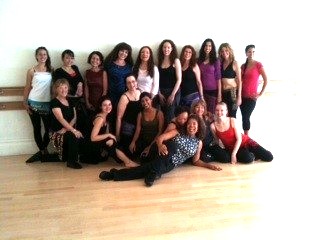 Home
Home
June 8. 2012
Friday
Sahra
Sahra arrived tonight at exactly the same moment
that our "take-out" dinner arrived. She had called from Livermore
and told me she was almost here, I waited a bit and then called in the
order. How's that for perfect timing? Sahra was in good spirits even though
she had driven longer than expected due to being held up in a brush fire
and a detour.
It was great to see Sahra and I wished that we lived closer so we could
hang out more often. Although on thinking about that, I'm sure that if
we lived closer I wouldn't see her any more frequently as she seems to
be on the road travelling from one workshop to another almost 24/7. The
time she is at home seems to be very precious to her and she wants to
spend it working in her garden or doing other household projects. It seems
that her favorite TV programs are on the DIY channels.
I wonder what it must be like to travel like she does. I am such a homebody.
I like staying at home so much that I've always just taught in my home
studio. When I first started teaching, I rented a studio exactly one block
from my home so I could be close to home. When I lost that studio, we
decided that it would be better to have a home studio rather than move
further from home and rent again. I've never regretted it.
The only place I ever taught on-going classes besides in my studio was
at the Mission Cultural Center which is a few minutes by car or
walking distance from my house. I taught there for twelve years. I would
dash there every Saturday after my classes ended lugging my boom box,
cassettes and CDs and whatever props I needed such as tambourines, canes,
cymbals and veils. Today I get tired just thinking that I did that for
so many years. Plus, I would park three blocks away to keep from getting
a parking ticket or having to feed a meter.
Yes, I must have been crazy. But it was what I called my "community
service". Now I just serve my community on Elizabeth Street and only
have to lug myself down a flight of stairs to the studio.
But to travel every week to a different town or state or country wears
me out just thinking about it. It must be great, stimulating and exciting
to meet dancers from other areas and share the knowledge like that, but
I really don't think I could do it. I can barely get myself together to
go to BDUC in Long Beach once a year. I get so nervous and stressed
about one teeny little hour long workshop class. Just worrying about one
little workshop drives me and my students crazy for a couple of months
before and then it takes about a month after for me to recover.
Let me tell you. I greatly admire people who do this workshop circuit
and I love to live vicariously by hearing them tell me of their experiences.
But, for me, there's something very exciting and stimulating to find a
new or new old piece of music in my own studio and then just spontaneously
start teaching to it. Home
June 7, 2012
Thursday
Wahashtini - Finally finished it.
Tonight we finally finished the last of "Wahashtini".
It's been fun working on the same song for almost a month - even if it
is a song I would never dance to.
I noticed that everyone really felt comfortable dancing to the first two
parts and really seemed to recognize words and even phrases. Now if we
can only transfer that same ease with other songs. I've been trying to
stress that even if they don't know the words, the very fact that they
can hear and recognize hearing a word makes their dancing have more dimension.
Between knowing some words, knowing some rhythms and knowing Hossam
Ramzy's generic song translation the dance should have more depth.
Hossam Ramzy's generic song
translation from "Ask Hossam":
'I love you, you used to love me, now I am hurt, because you hurt me,
thank you for hurting me, it is so delightful to be hurt by you, I love
being hurt and brokenhearted by you...If anyone else was to try to break
my heart, I will refuse it, because I only accept my heat to be broken
by YOU. YA HABIBI.'"Home
June 6 2012
Wednesday
The Dahola and Susu
I got to play my Dahola in a class tonight. It
sure is fun to play. Sometimes I think I have too many drums and then
I feel I really don't, I just don't have enough space for all the drums
that I have. The Dahola I played tonight is one that I bought from Pepper.
It's a vintage Dahola with a black naughahyde covering and sounds great.
It's different in sound than the one I bought from Shadi of Diamond Pyramid.
Besides sounding deep and rich, it is absolutely beautiful with an inlaid
mother of pearl mosaic design. Shadi chose it and sold it to me
because he liked Susu. Sometimes it really pays off to be Susu's
mother.
She chose first to be a musician and I have benefitted from taking drum
lessons from her.
But at one time she benefitted from being
my daughter by learning how to dance. Well, she only wanted to learn how,
in order to be a better dancer's drummer, but she did learn. And, I hope
that she had fun learning.
But, I wonder where she got her musical genes -
and curly hair. Certainly not from her mother.Home
June 5, 2012
Tuesday
More cake?
Spent the entire day devoted to dance, music or the Arab
world.
Started the day at the Arab Film Festival office working on more
new submissions. It's kind of fun going through them and am looking forward
to when I can see them from beginning to end. I hope this will be soon.
Went to Ayman's and we worked on "Aiza Aris", a song by Marwa. I want to use it as my workshop song for Carnival of Stars. Marwa is a Lebanese singer who was influenced by Egyptian singers Layla Nazmi and Shadya. Layla Nazmi who was popular in the 60's sang beledy type songs in the dellae style of spoiled brat "cute".
I have a numer of Layla Nazmi LPs with her dressed in beledy outfits. Some of Marwa's songs are styled in Egyptian beledy dellae. In fact, there have been a number of Lebanese singers who seem to have been influenced by this particular school of singing.
Another one is Dominique. Her popular song "Atrees" is a good example.
Now I just have to start working on a choreography. Too bad I have a bad
memory for choreography. I already had a choreography to this song. Used
to perform it at The Excelsior. Now I'll have to start from scratch
but maybe not. Quite often old dance steps and combinations start to appear
out of nowhere when I work on songs that used to have choreographies.
Tonight after Aswan practice I was gifted with another birthday
cake. This has become a birthday tradition. Here I am at the Bagdad at
my 35th birthday.
I know I like cake and this one was outstanding, but, how many cakes can a person eat? There's absolutely no way I can lose weight when people keep forcing cake on me. I know I should have will power. And I do, to a point. But not when it's in my face, and I want to have some and I have to be polite and eat it. I hope I didn't offend anyone when I didn't seem overly happy with yet another cake.Home
June 4, 2012
Monday
Counting masmudi, chifte and wahedeh without counting.
The big thing that I am trying to do in drum class is
show how to count without actually counting. This is by having the hands
and body memorize a rhythm as a unit of measure and just know how to do
play it automatically without thinking about it. The girls in class are
almost at that point but not quite. We work a lot on drilling the rolls
- the threes, the fours, the fives and the sixes and then applying these
rolls to certain rhythms.
I think their favorite rhythm is the wahedeh which is a 4 count rhythm.
It has two rolls in it.- the five and the six. They all can do this without
thinking. Then we do the masmudi which is an 8 count rhythm (masmudi kabeer,
not sagheer). This has a three roll, a four roll, a five roll and a six
roll. The rolls just get progressively longer. They have an easy time
with the second half of the rhythm, but then, that's the wahedeh. The
first half is a little harder because it's not totally automatic in their
hands yet. They can say it, but they can't always play it. The chifte
telli is easy for them to play if we accompany a piece of music but they
still have a bit of trouble doing it on their own. I'm patient and know
that it will come eventually. Home
June 3, 2012
Sunday
The Aswat concert,
Finally today we were able to show what we've been working
on for the past few months. Hurray! It's over. Khalas! Finally. No more
two plus times a weeks of driving to the East Bay to rehearse. I get my
Sundays back. Yay!!
Well the concert went really well. Of course there were minor glitches.
Is there ever going to be a show without technical difficulties? But the
ensemble and the singers did well. Now, if only we can get the help and
the volunteers to get the box office and the sound without a hitch, we'll
have a great show. It's nice to know that we, the fannan, the artists,
the singers and the musicians were well rehearsed. Thanks to ourselves.
Thanks to Nabila and Thanks to Omar
.
In a few days I'm sure I'll be able to give you the you tube links to
hear for yourselves.
After the concert, we went to the Sahara in Burlingame for the
after party. This was great fun and I was especially happy to see Fadi
Hanani who is part owner with Murad Bshar. I've known Fadi
for years and thought about how we met.
I was dancing with my group, The Aswan Dancers, at a church festival
called the Jerusalem Festival. Fadi was singing and I approached
him and told him that I had a band called the Arabian Knights and we were
looking for a singer. He gave me his card.
Later I called him and asked him to come to our club. We were playing
at El Valenciano at the time. He told me that he only sang at church
festivals, but he would check us out. Jacques al Asmar, my partner
in crime, convinced him to join our band and the rest was history!
We enjoyed a good seven years working together as The Arabian Knights every weekend at various venues, most notably at El Valenciano and Tropigala. The Arabian Knights were Jacques and me plus at various times - Reda Darwish, Loay, Susu, Faisal, Manaf, Emiliano and others on percussion - Raed, Murad and Khader on keyboard, Shar, bass guitar, Fouad, kanun, Georges, violin, Elias, accordion, Nazir, oud, Husain, oud and violin and Gunsu, Safwan, Fadi and Jamal Kassab singing. I know I am missing some of the other musicians and singers, but those are the ones who come immediately to my memory.
Also during breaks we had Raffy as DJ.
Yes, I spent many wonderful nights playing back-up percussion directly
behind Fadi watching him sing and wiggle and dance. Fadi reminded me of
what a great family we were at the time and what great times we had.
Jacques and I were the Arabian Knights founding members. We were the two
dancers who wanted to create the perfect band for dancers so we could
selfishly dance to it. But then we found that we had to be in the band
to try to keep it perfect or more full sounding. Unfortunately we usually
had to watch other dancers dance to the music that we wanted to dance
to. Once in awhile we got to dance but that was not too often, because
we had to be with the band.
Now Jacques has taken a break to go back to school, but here I am still
with a band trying to help create the perfect band for dancers. Now I'm
with the Pasha Band, Mohamed Amin's Band and Georges Lammam's
Band and still secretly wishing to be on the dancer's side of the
stage. Oh well. Son cosas de la vida. Maalesh. At least I'm trying to
make that perfect sound for the dancers and I get to be on the stage....somewhere
on the stage. Not on the dancer's side of the stage, but at least on the
stage. Home
June 2, 2012
Saturday
Tori's wedding
My son's daughter got married today. She married into
a Mexican family from Oaxaca and the groom told me it was a typical Mexican
wedding. Towards the end of the festivities, the bride and groom were
brought to the center of the dance floor and told to stand on chairs,
facing each other and holding hands. Various people held the bride and
groom anchored securely and the guests - female for the bride and male
for the groom held hands and alternately wove a running "baile
de la vivora" snake line between the two chairs under the couple
holding on literally for "dear life". Of course there was lots
of laughing and yelling until they finally knocked down Carlos,
the poor groom. After almost smothering him by their bodies they then
proceeded to group together and start
throwing him in the air. It was fun to watch and was very reminiscent
of what I've seen at some Arab weddings.
Although already over full from birthday cakes and with a refrigerator
of left over cake waiting for me, of course I had to taste test the wedding
cake. Propriety told me to stop after the second helping. It was hard
to stop, so we left to go home. Home
June 1, 2012
Friday
Aswat and Cakes
Today was just another day with the exception that it's
my birthday so according to my demands, I get a cake. Gregory gave
me a beautiful Red Velvet cake that Susu, Gregory and I consumed
with great gusto. I also require watermelon for my birthday so we washed
down all that sweet with cool and soothing watermelon that was so refreshing
and not so sweet compared to the cake.
Later we went to the final Aswat practice for this Sunday's concert.
I still couldn't get into writing all the changes and decided that I needed
to really concentrate and commit all the changes to memory- motor and
brain. I really do admire and wonder how Susu is able to do it. I guess
that's why she's the drummer and I'm so content being a back-up player.
Since she's been taking oud lessons from Omar, she will also play oud
with the oud ensemble.
After rehearsal Susu and Najwa had arranged for more cakes. It
was Guilnard's birthday and also mine. We each got a cake. A carrot
cake and a triple chocolate cake. They were both wonderful. At the end
of the night I had to take both of those cakes home. Guilnard, who has
a beautiful figure, refused to take hers home. How could I leave the cakes
there to go in the trash? My grandmother's voice kept telling me: "Think
of the poor starving people in China." I don't know what that has
to do with anything but I guess the diet can always start tomorrow.
Home
May 31, 2012 (This was added at the same time as June baolek eh)
Contact us
